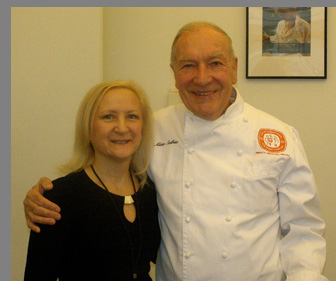Chef Alain Sailhac and Debra C. Argen
Taking a class at The International Culinary Center in New York City with Chef Alain Sailhac in April 2016 was an unparalleled experience and an honor. Born in Millau in the southern part of France, Chef Alain Sailhac has a culinary resume of excellence and achievement. Beginning his culinary career at age 14 as an apprentice, he honed his craft working in highly regarded restaurants in France and in the United States including New York’s prestigious restaurants, Le Cygne, Le Cirque, 21 Club, at the Plaza Hotel and at the Regency Hotel. He joined the French Culinary Institute (which became The International Culinary Center "The ICC") as Dean of Culinary Studies in 1991 and now holds the position of Dean Emeritus.
His distinguished career highlights and achievements include receiving a Silver Toque, Chef of the Year award from the Maîtres Cuisiniers de France (Master Chefs of France), together with his wife, Arlene Feltman Sailhac, he received the Silver Spoon award from Food Arts magazine, he was inducted into the James Beard Foundation’s "Who’s Who in Food and Beverage in America," and he received France’s Order National du Mérite (National Order of Merit Award), and the Chevalier du Mérite Agricole.
Chef Alain Sailhac Menu – NYCE 2016
Bouillabaisse, Fish Stew, Marseillaise-Style, with Atlantic Bounties
Raspberry Crème Brûlée
Suggested wine pairing: Banfi Centine Bianco
Although I love bouillabaisse, I had never made it. During the course of the 2-hour and 15-minute class at The ICC, I learned about the origins of bouillabaisse, and also learned about the amount of effort, time, and ingredients that go into making this ever so tasty, classic French recipe. I now have a new appreciation for bouillabaisse, as well as for the chefs who make it.
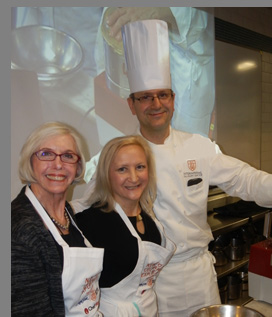
Nancy Stone, Debra C. Argen and
ICC Chef Bauer
Chef Alain Sailhac told the class about the history of bouillabaisse noting, "Bouillabaisse was not an expensive dish 75 years ago, and the most famous bouillabaisse was done in the town of Marseille. Now, bouillabaisse is a very expensive fish stew and this famous dish is consumed only in a few very expensive restaurants specializing in seafood. I was very fortunate to eat bouillabaisse in many parts of France at different restaurants, all of which had different ways to cook it."
"In the St. Tropez region, a few specialized restaurants cook their bouillabaisse with a lot of wood fire, bringing the fish soup and the fish to a very high temperature, and served the soup separate from the fish. In a very expensive seafood restaurant, the sauce is done with almost a dozen different little fish called poissons de roche, or rockfish. The fish are seasoned and cooked fast with a few ingredients, spices, and the indispensable saffron. The fish is blended into a puree, reduced, and strained to make the soup. It is served with rouille and very expensive fish like bar or rouget." (Note: Rouille is a spread made with garlic, firm white bread, potatoes, fish soup, egg yolks, cayenne pepper, saffron, and olive oil.)
Making Bouillabaisse
Working in student teams of two, Chef Alain Sailhac, assisted by ICC Chef Instructor Marc Bauer, and volunteers, we broke down each process and worked step-by-step to create an incredibly tasty bouillabaisse.
Step One – Make the Soup
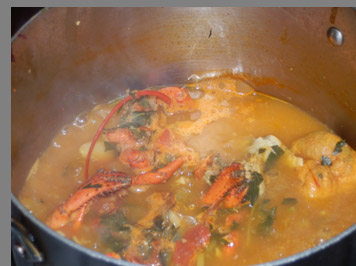
Sauté
We first created the soup by assembling, chopping, and sautéing our ingredients of big fish heads, lobster bodies, and shrimp shells in olive oil with onions, fennel bulbs, leeks, shallots, garlic, tomato paste, tomatoes, thyme, parsley, anise stars, and anise seed.
Then we added white wine, water, Pernod, saffron, orange and lemon zest, salt and pepper, cayenne pepper, and Old Bay Seasoning to the seafood., and brought it to a boil.
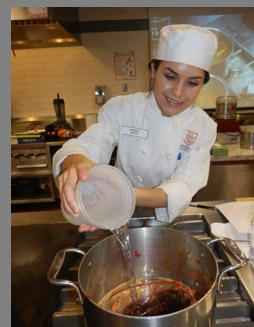
Andrea Nieto Adding Water
The final step for the soup was pureeing the ingredients until smooth and straining to ensure no shell pieces remain. At home you can do this with a blender, vita prep, or immersion blender. In class, volunteer Jeffrey De Jesus used an industrial size machine to puree all of the students’ soups together.
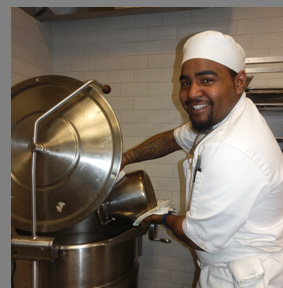
ICC Volunteer Jeffrey De Jesus
Step Two – Fish for the Bouillabaisse
We assembled our seafood which included striped bass, flounder, monkfish, grouper, lobsters, littleneck clams, and shrimp. Chef Alain Sailhac noted that Marseilles makes the best bouillabaisse due to the small fish they have there.
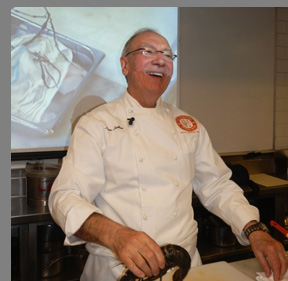
Chef Alain Sailhac
Step Three – Create Garnishes
Garnishes included tomatoes, leeks, fennel, oil, garlic, and basil. Chef Alain noted that in some parts of the Mediterranean they also add potatoes.
Step Four – Make the Rouille
We created the spread by blending garlic, firm white bread, potatoes, fish soup, egg yolks, cayenne pepper, saffron, and olive oil.
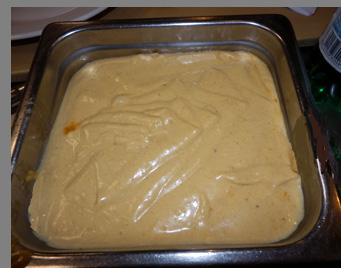
Rouile
Step Five – Make the Croutons
We cut baguettes on the bias, rubbed both sides of the slices with raw garlic, brushed them with olive oil on both sides, and baked them until golden.
Step Six – Make a Fish Marinade
Next, we marinated the fish with saffron, garlic paste, and olive oil. (Cook the fish and seafood just before serving.)
Step Seven – Cook the Bouillabaisse
We heated the soup with a portion of the various fish, brought it to a boiling point, then lowered the temperature, added clams, a piece of lobster on top of the fish, tomatoes, and basil to finish the bouillabaisse.
Step Eight – Presentation
Bouillabaisse can be presented to guests in a small saucepan and ladled into individual bowls tableside carefully spooning fish and seafood into the bowl, or plated in the kitchen.
Serve the croutons and a small bowl of rouille on the side.
Step Nine – Finish
We students gave each other a pat on the back for our accomplishment and then savored the delicious efforts of our teamwork.
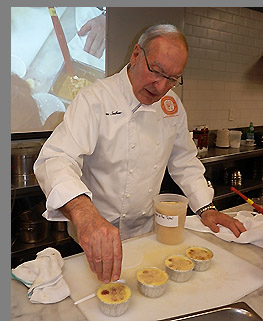
Chef Alain Sailhac making Raspberry Crème Brûlée
Making Raspberry Crème Brûlée
After making the more complicated bouillabaisse, we learned to make Raspberry Crème Brûlée with egg yolks, sugar, cream, vanilla bean, and raspberries, a dessert made famous in America at New York’s Le Cirque Restaurant by Chef Alain Sailhac. This dessert is so delectable that it is hard to believe that it is so easy to make.
Raspberry Crème Brûlée
Yield: 4 Servings
Equipment Needed: 4 ramekins or molds
Ingredients for 4 Servings:
|
5
|
Large
|
Egg Yolks
|
|
.25
|
Cup
|
Sugar
|
|
2
|
Cups
|
Cream
|
|
0.5
|
Vanilla Bean, split lengthwise
|
|
|
20
|
Raspberries, do not wash
|
Method: In a small bowl, combine the egg yolks, and one-quarter cup of the sugar; whisk until homogenous. Bring the cream to a simmer with the vanilla bean, let steep for 20 to 30 minutes.
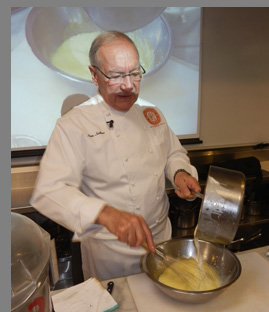
Chef Alain Sailhac demonstrating combining egg yolks
Whisk the cream into the egg mixture. Remove foam with parchment paper, Pour into 4 molds; add 4 to 5 raspberries in each mold. The custard should almost reach the rim of the molds.
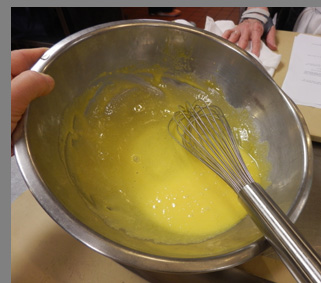
Mixing Eggs and Sugar
Bake at 325° F (163° C) until set.
Let cool down, when room temperature, refrigerate for several hours.
Note: The custard must be well chilled before you brown the sugar with the blow torch or else the custard will warm up and start to melt.
Sprinkle sugar on the custard, remove the excess; clean the side of the ramekins with a paper towel. Brown and burn the crème brûlée with a blow torch or a salamander (broiler). Serve immediately when the cream is evenly browned with slight hints of burned sugar.

Chef Alain Sailhac TorchingRaspberry Crème Brûlée
Merci beaucoup (thank you) to Chef Alain Sailhac and the NYCE 2016, for bringing a delectable taste of classic French recipes to The ICC; I cannot wait to make the recipes at home. Bon Appétit!
 Want more information on the next NYCE? For more information about the New York Culinary Experience, contact Stephanie Fray at nyce@nymag.com or +1-646-314-4413.
Want more information on the next NYCE? For more information about the New York Culinary Experience, contact Stephanie Fray at nyce@nymag.com or +1-646-314-4413.
Location and Information
The International Culinary Center
462 Broadway
New York, New York 10013
United States
Toll-Free Telephone:+1-888-324-2433
Email: info@internationalculinarycenter.com
Website: www.IinternationalCulinaryCenter.com
Follow The International Culinary Center on Facebook at www.facebook.com/InternationalCulinaryCenter
Follow Luxury Experience on Facebook at www.facebook.com/LuxuryExperience to see more photos and watch video clips.
Follow Luxury Experience on Twitter at www.twitter.com/LuxuryPair
© September 2016. Luxury Experience. www.LuxuryExperience.com. All rights reserved.

